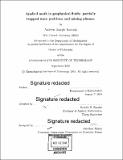| dc.contributor.advisor | Rodolfo R. Rosales. | en_US |
| dc.contributor.author | Rzeznik, Andrew Joseph | en_US |
| dc.contributor.other | Massachusetts Institute of Technology. Department of Mathematics. | en_US |
| dc.date.accessioned | 2019-03-01T19:55:45Z | |
| dc.date.available | 2019-03-01T19:55:45Z | |
| dc.date.copyright | 2018 | en_US |
| dc.date.issued | 2018 | en_US |
| dc.identifier.uri | http://hdl.handle.net/1721.1/120657 | |
| dc.description | Thesis: Ph. D., Massachusetts Institute of Technology, Department of Mathematics, 2018. | en_US |
| dc.description | Cataloged from PDF version of thesis. | en_US |
| dc.description | Includes bibliographical references (pages 129-132). | en_US |
| dc.description.abstract | The first portion of this work focuses on leaky modes in the atmospheric sciences. Leaky modes (related to quasi-modes, scattering resonances, and the singularity expansion method) are discrete, oscillatory and decaying modes that arise in conservative systems where waves are partially trapped. By replacing the infinite domain with a finite domain and appropriate boundary conditions it is possible in many cases to construct a complete basis for the solution in terms of these modes. Formulating such effective boundary conditions requires a notion of the direction of propagation of the waves. For this purpose we introduce a generalization of the concept of group speed for exponentially decaying but conservative waves. This is found via an extended modulation argument and a generalization of Whitham's Average Lagrangian theory. The theory also shows that a close relationship exists between the branch cuts of the dispersion relation and the propagation direction, and is used to create spectral decompositions for simple problems in internal gravity waves. The last chapter considers deep-sea nodule mining operations, which potentially involve plans for discharge plumes to be released into the water column by surface operation vessels. We consider the effects of non-uniform, realistic stratifications with vertical shear on forced compressible plumes. The plume model is developed to account for the influence of thermal conduction through the discharge pipe and an initial adjustment phase. We investigate the substantial role of compressibility, for which a dimensionless number is introduced to determine its importance compared to that of the background stratification. Our results show that (i) small-scale stratification features can have a significant impact, (ii) in a static ambient there exists a discharge flow rate that minimizes the plume vertical extent, (iii) the ambient velocity profile plays an important role in determining the final plume scale and dilution factor, and (iv) for a typical plume the dilution factor is expected to be several hundred to a thousand. | en_US |
| dc.description.statementofresponsibility | by Andrew Joseph Rzeznik. | en_US |
| dc.format.extent | 134 pages | en_US |
| dc.language.iso | eng | en_US |
| dc.publisher | Massachusetts Institute of Technology | en_US |
| dc.rights | MIT theses are protected by copyright. They may be viewed, downloaded, or printed from this source but further reproduction or distribution in any format is prohibited without written permission. | en_US |
| dc.rights.uri | http://dspace.mit.edu/handle/1721.1/7582 | en_US |
| dc.subject | Mathematics. | en_US |
| dc.title | Applied math in geophysical fluids : partially trapped wave problems and mining plumes | en_US |
| dc.title.alternative | Partially trapped wave problems and mining plumes | en_US |
| dc.type | Thesis | en_US |
| dc.description.degree | Ph. D. | en_US |
| dc.contributor.department | Massachusetts Institute of Technology. Department of Mathematics | |
| dc.identifier.oclc | 1088414110 | en_US |
